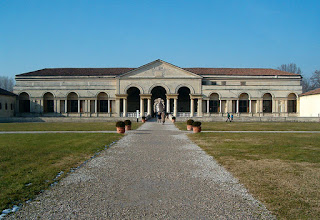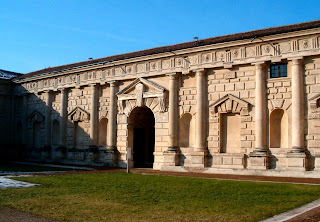Painter from Rome left his mark on Mantua
 |
| Titian's portrait of Giulio Romano, painted between 1536 and 1540 |
He is most remembered for his masterpiece, the Palazzo del Te, built on the outskirts of Mantua as a pleasure palace for the Gonzaga family, which was designed, constructed and decorated entirely by him and his pupils.
The artist had been born in Rome some time in the 1490s and was given the name, Giulio di Pietro di Filippo de’ Gianuzzi. He was known originally as Giulio Pippi, but later was referred to as Giulio Romano because of where he was born.
Giulio was apprenticed to Raphael when still a child and worked on the frescos in the Vatican loggias to designs by Raphael. He also collaborated with him on the decoration of the ceiling in the Villa Farnesina.
He became so important in the workshop that on Raphael’s death in 1520 he was named as one of the master’s chief heirs and he also became his principal artistic executor, completing a number of Raphael’s works, including the Transfiguration.
 |
| Romano's 1523 painting The Stoning of St Stephen |
The following year, at the invitation of the Gonzaga family, Giulio left Rome for Mantua, where he remained until his death, completely dominating the artistic affairs of the duchy.
In Mantua he worked on the rebuilding of the ducal palace and his decorations in the Sala de Troia are thought to foreshadow the Baroque style.
He also sculpted the figure of Christ that is positioned above Castiglione’s tomb in the Church of Santa Maria delle Grazie just outside Mantua.
 |
| Romano's Palazzo del Tel is |
Drawings by Giulio that are still in existence are treasured by collectors and contemporary prints of them, engraved by Marcantonio Raimondi, made a significant contribution to the spread of Italian style throughout Europe.
The architect built a house for himself in Mantua, which was a Mannerist version of Raphael’s house in Rome. He started rebuilding the city’s cathedral the year before his death, in 1546.
Giulio Romano was buried in the Church of San Barnaba in Piazza Giuseppe Bazzani in Mantua.
 |
| The Palazzo Ducale in Mantua was the seat of the ruling Gonzaga family |
Mantua is an atmospheric, old city in Lombardy, to the southeast of Milan, famous for its Renaissance Palazzo Ducale, the seat of the Gonzaga family between 1328 and 1707. Giulio Romano was well paid by the Gonzaga family and could afford to build his own residence in Via Carlo Poma. He reconstructed it from existing buildings, creating an elegant stone façade with arched windows on the upper floor. It still stands as an example of his genius and has some of his original frescos inside.
 |
| The Palazzo del Te was designed as a pleasure palace considered to be Giulio Romano's masterpiece |
Palazzo del Te, designed for Federico Gonzaga as a summer residence, is a fine example of the Mannerist school of architecture and is considered to be Giulio Romano’s masterpiece. The name for the palace came about because the location chosen had been the site of the Gonzaga family stables at Isola del Te on the edge of the marshes just outside Mantua’s city walls. After the building was completed in about 1535, a team of plasterers, carvers and painters worked on the interior for ten years until all the rooms were decorated with beautiful frescoes.
More reading:
The outstanding legacy of Mannerist painter Parmigiano
Why Bronzino is regarded as the master of the Mannerist movement
Salomone Rossi and the enlightenment of the Mantua court
Also on this day:
1512: Michelangelo's Sistine Chapel ceiling revealed
1596: The birth of painter and architect Pietro da Cortona
1757: The birth of sculptor Antonio Canova
Home


